Dynamic user role adaptation tools are reshaping how small and medium-sized enterprises (SMEs) manage access control. These tools adjust user permissions in real time based on factors like behavior, device, and location, offering smarter security and compliance solutions. Here's a quick look at the seven leading tools:
- Okta Adaptive MFA: Real-time risk assessment, 7,000+ integrations, cloud-based scalability.
- Microsoft Entra ID: Machine learning-driven access control, seamless Office 365 integration, flexible pricing.
- IBM Security Verify: AI-powered analytics, strong compliance tools, hybrid deployment options.
- SailPoint IdentityNow: Automated provisioning, compliance-focused, ideal for identity governance.
- ForgeRock Identity Platform: Behavioral monitoring, API-first design, supports hybrid systems.
- One Identity Manager: Policy-driven automation, extensive integration, tailored for complex setups.
- Ping Identity: Risk-based authentication, robust compliance standards, scalable for SMEs.
Each tool offers unique strengths in real-time monitoring, regulatory compliance, and integration capabilities. While Okta and Microsoft Entra ID stand out for affordability and ease of use, IBM and Ping Identity cater to highly regulated industries. For SMEs, choosing the right tool depends on budget, IT resources, and growth plans.
Quick Comparison:
| Tool | Real-Time Monitoring | Compliance Standards | Integration Options | Pricing (starting) | Best For |
|---|---|---|---|---|---|
| Okta Adaptive MFA | Yes | SOC 2, ISO 27001 | 7,000+ pre-built connectors | ~$2/user/month (custom) | Scalable, low-cost |
| Microsoft Entra ID | Yes | GDPR, HIPAA, more | Office 365, 3rd-party apps | $6/user/month | Office 365 users |
| IBM Security Verify | Yes | HIPAA, SOC 2, PCI DSS | SaaS, on-premises, hybrid | Contact for pricing | Enterprise-level needs |
| SailPoint IdentityNow | Yes | GDPR, SOX | Cloud-first, SaaS apps | Enterprise pricing model | Identity governance |
| ForgeRock | Yes | HIPAA, SOC 2 | APIs, hybrid environments | Custom enterprise pricing | Flexible systems |
| One Identity Manager | Yes | SOC 2, HIPAA | SAP, Azure, Google Suite | Quote-based pricing | Complex setups |
| Ping Identity | Yes | SOC 2, ISO 27001 | SAML, OAuth, SCIM | Tiered pricing available | SMEs needing scalability |
For SMEs, tools like Okta and Microsoft Entra ID balance cost and usability, while IBM and Ping Identity offer more advanced features for compliance-heavy industries. Evaluate based on your specific security, compliance, and growth needs.
Dynamic Access Roles: Simplifying Role Management - Navigate 2024
How to Select Dynamic User Role Adaptation Tools
Picking the right dynamic user role adaptation tool is all about finding features that enhance security while keeping things efficient - especially for small and medium enterprises (SMEs). Let’s break it down into four essential capabilities that can guide your decision-making process.
Real-time behavioral analysis is a must-have. Why? Because it keeps an eye on user activities to spot anything out of the ordinary. Considering that about 75% of breaches stem from human error, having a tool that flags unusual access patterns can be a game-changer. This is especially important for SMEs that might not have a dedicated security team. Look for tools offering real-time monitoring and instant alerts to catch unauthorized access before it becomes a problem.
Compliance support should be high on your list, particularly if your SME operates in the U.S., where navigating regulations like GDPR, HIPAA, or CCPA can be tricky. Role-based access control (RBAC) tools can help you stay on top of these rules by enforcing strict access controls and keeping detailed logs of who accessed what and when. These audit trails make compliance reporting easier and help you spot suspicious activity quickly. Since small businesses often underestimate cybersecurity risks, prioritizing tools that simplify compliance while keeping operations smooth is essential.
Integration capabilities are another key factor. A good tool should fit seamlessly into your existing tech setup. Think directories, HR systems, cloud platforms, on-premises apps, and VPNs. For example, integration with HR systems can streamline user onboarding and offboarding, while pairing with identity management solutions centralizes authentication and authorization. When evaluating tools, consider how well they’ll work with your current software and whether the admin interface is user-friendly enough for your team.
Scalability is critical for growing businesses. Your chosen tool should handle a growing workforce and more complex role structures. For SMEs experiencing rapid growth or seasonal shifts, automated role provisioning and de-provisioning can be a lifesaver. These features assign and revoke access rights as employees change roles or leave, cutting down on admin work and minimizing security risks.
The ultimate goal is to balance security with usability. Your team needs access to the tools they require without putting sensitive information at risk. Enforcing the principle of least privilege - granting users only the access they need for their specific roles - is a smart move.
Before diving into any tool, take some time to document your existing roles and the functions they require. Start with minimal permissions and scale up as needed. Regularly auditing permissions and sticking to standardized role naming conventions can help you spot and remove unnecessary access, reducing confusion and potential errors. These steps will set the stage for evaluating the top tools in the next section.
1. Okta Adaptive MFA
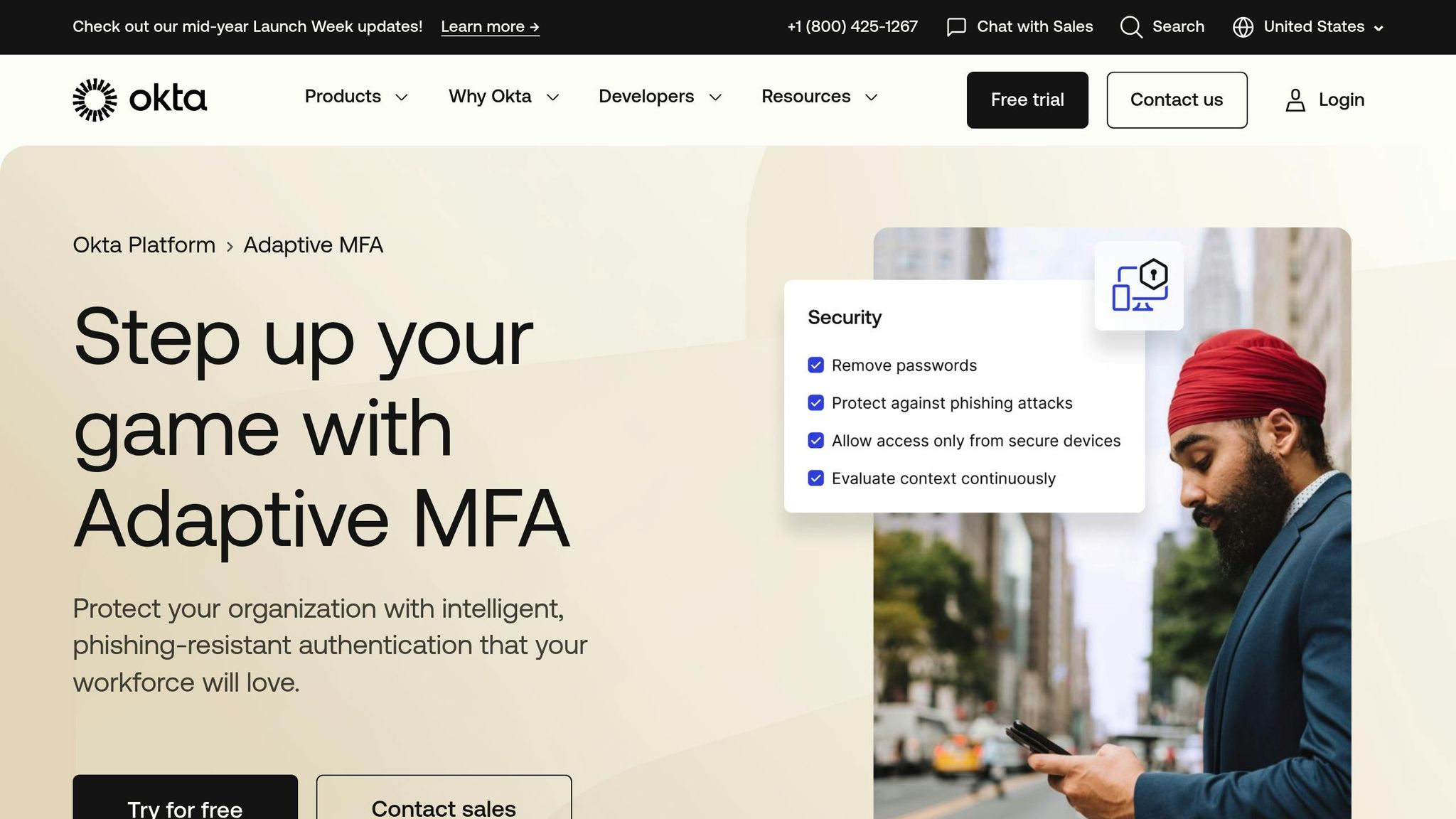
Okta Adaptive MFA tailors security measures in real-time, adapting to user behavior to enhance protection for small and medium-sized enterprises (SMEs).
Real-Time Behavioral Analysis
Okta Adaptive MFA uses contextual data to monitor factors like device details, location, login times, and frequency. This information helps assign risk scores and decide whether extra verification is needed. For instance, if someone who typically logs in from New York suddenly accesses the system from an unusual location at 3 AM, the system flags it as high-risk and requests additional authentication. The ThreatInsight feature adds another layer of security by automatically blocking suspicious IP addresses and reassessing a device's security state after a single sign-on session, reducing the risk of session hijacking. Thanks to these features, organizations have reported cutting the time spent on second-factor prompts by about 50%.
"In the last year, Okta has become one of the single most important pieces of our security stack. From a security perspective, it's only increasing in importance."
– Eric Richard, SVP of Engineering and CISO
These risk assessments also support compliance efforts, making it easier to meet regulatory requirements.
Compliance Support
Okta Adaptive MFA aligns with major compliance standards like HIPAA and SOC 2. Its cloud-based setup offers detailed audit trails, strong access controls, and governance tools, simplifying compliance audits by keeping a thorough record of authentication events.
Integration Capabilities
One of Okta's standout features is its extensive integration ecosystem. With over 7,000 pre-built integrations and compatibility with more than 500 SAML-enabled applications, it seamlessly connects with existing systems and applications. It even works with VPNs and on-premise setups through its RADIUS server agent.
"The risks involved make MFA for apps and services vital for data protection. We love the fact that Okta Adaptive MFA is easy to use and we can choose from factors like SMS and Okta Verify."
– Michael Ibbitson, CIO, London Gatwick Airport
Scalability for SMEs
Scalability is crucial for growing businesses, and Okta Adaptive MFA delivers. Its cloud-based design eliminates the need for costly hardware, allowing organizations to scale effortlessly as they grow. By automatically adjusting authentication requirements based on risk, it also reduces the workload for IT teams.
"We have one place where we can validate our security posture. Dev teams now have just one token to worry about. They do authentication and authorization in a consistent way no matter where they're deployed."
– Trey Ray, Manager, Cybersecurity
2. Microsoft Entra ID (formerly Azure Active Directory)
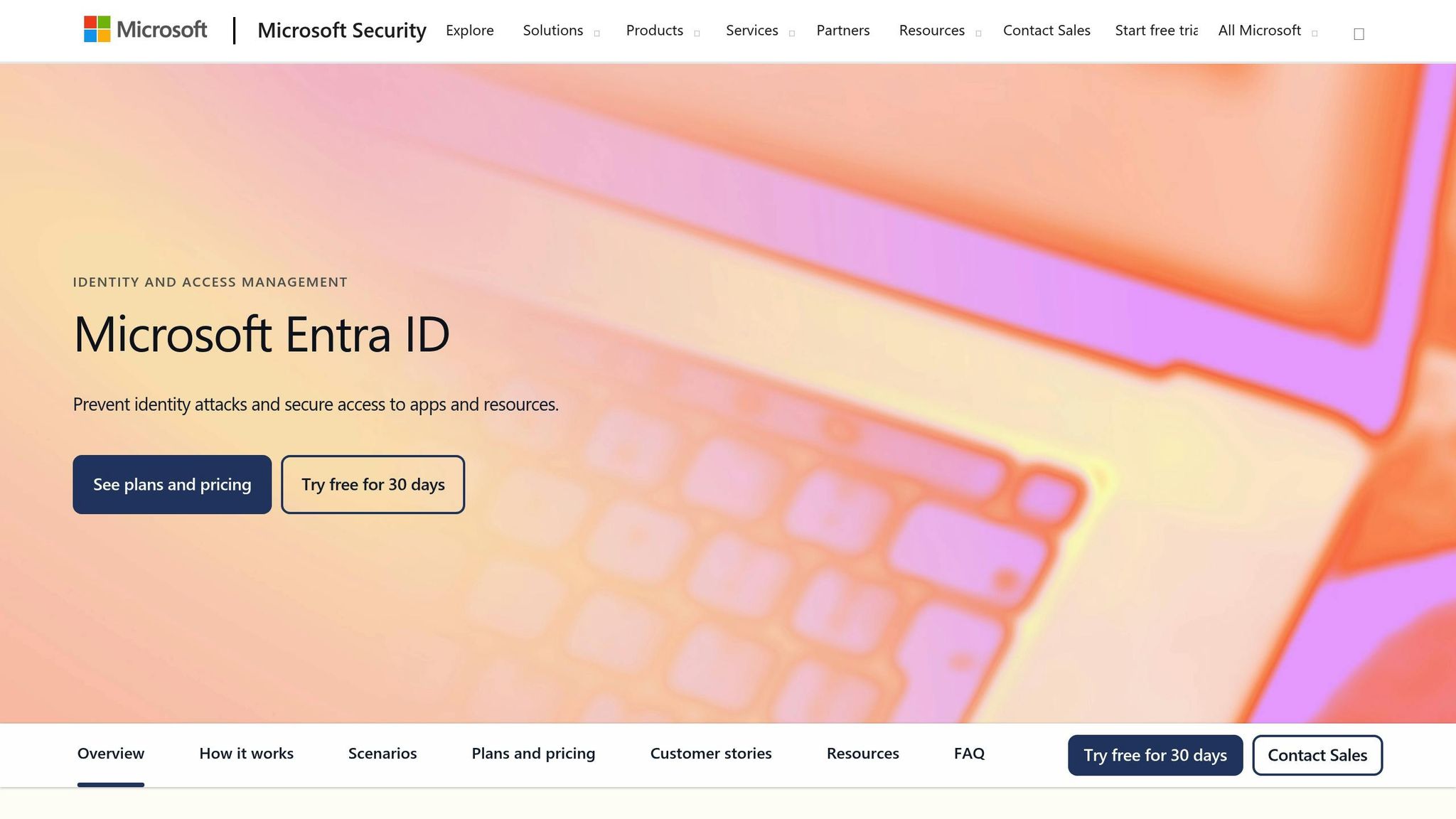
Building on the dynamic access control seen in Okta Adaptive MFA, Microsoft Entra ID provides a strong alternative, combining analytics-driven insights with seamless integration. By leveraging behavioral analytics and machine learning, it dynamically adjusts user access, making it an excellent option for small and medium-sized enterprises (SMEs) that need identity management with enterprise-level security.
Real-Time Behavioral Analysis
Microsoft Entra ID Protection uses advanced real-time sign-in detection to evaluate and assign risk levels to user sessions. With the ability to analyze 78 trillion security signals daily and detect 600 million attacks, it offers a proactive approach to threat management. Its integration with Microsoft Sentinel further enhances security by using User and Entity Behavior Analytics (UEBA) to create baseline user profiles and assign an Investigation Priority Score. This score helps IT teams focus on the most critical threats.
When suspicious activity is flagged, risk-based Conditional Access policies can automatically enforce additional authentication steps or prompt a password reset to mitigate potential risks.
Compliance Support
Microsoft Entra ID aligns with major compliance standards such as GDPR, HIPAA, ISO 27001, and SOC 2. These certifications make it a trusted solution for SMEs managing sensitive data.
"Microsoft Entra ID meets identity-related practice requirements for implementing Health Insurance Portability and Accountability Act of 1996 (HIPAA) safeguards." – Microsoft Learn
For businesses navigating regulatory requirements or cyber insurance mandates, Microsoft Entra ID Protection provides tools to meet and document compliance standards. It undergoes annual SOC 1 Type 2 and SOC 2 Type 2 audits for Office 365, ensuring continuous monitoring and adherence to security protocols. Additionally, it supports government-specific requirements and operates within GCC, GCC High, and DoD Office 365 environments for added flexibility.
Integration Capabilities
Microsoft Entra ID excels in integration, supporting over 720,000 organizations worldwide. It simplifies access to Microsoft services like Microsoft 365 and Dynamics 365, as well as third-party apps, through single sign-on (SSO). The platform is compatible with widely-used standards, including OpenID Connect, SAML, SCIM, SQL, and LDAP, enabling automated identity lifecycle management and governance.
Its free edition covers essential features such as user and group management, directory synchronization, basic reporting, self-service password reset, and SSO for Azure, Microsoft 365, and popular SaaS applications.
Scalability for SMEs
Microsoft Entra ID is designed with SMEs in mind, offering a flexible pricing structure and cloud-based architecture that eliminates the need for costly on-premises infrastructure. Pricing tiers include:
- Free Edition: Basic features for small-scale needs.
- P1 Plan: $6.00 per user/month.
- P2 Plan: $9.00 per user/month.
- Microsoft 365 Business Premium: $22.00 per user/month (all billed annually).
This tiered approach allows SMEs to start with core features and expand as their security and compliance needs grow. Automated provisioning and governance tools further ease the administrative burden, while businesses can designate their HR system as the source of record for user provisioning, ensuring streamlined operations and improved performance.
3. IBM Security Verify
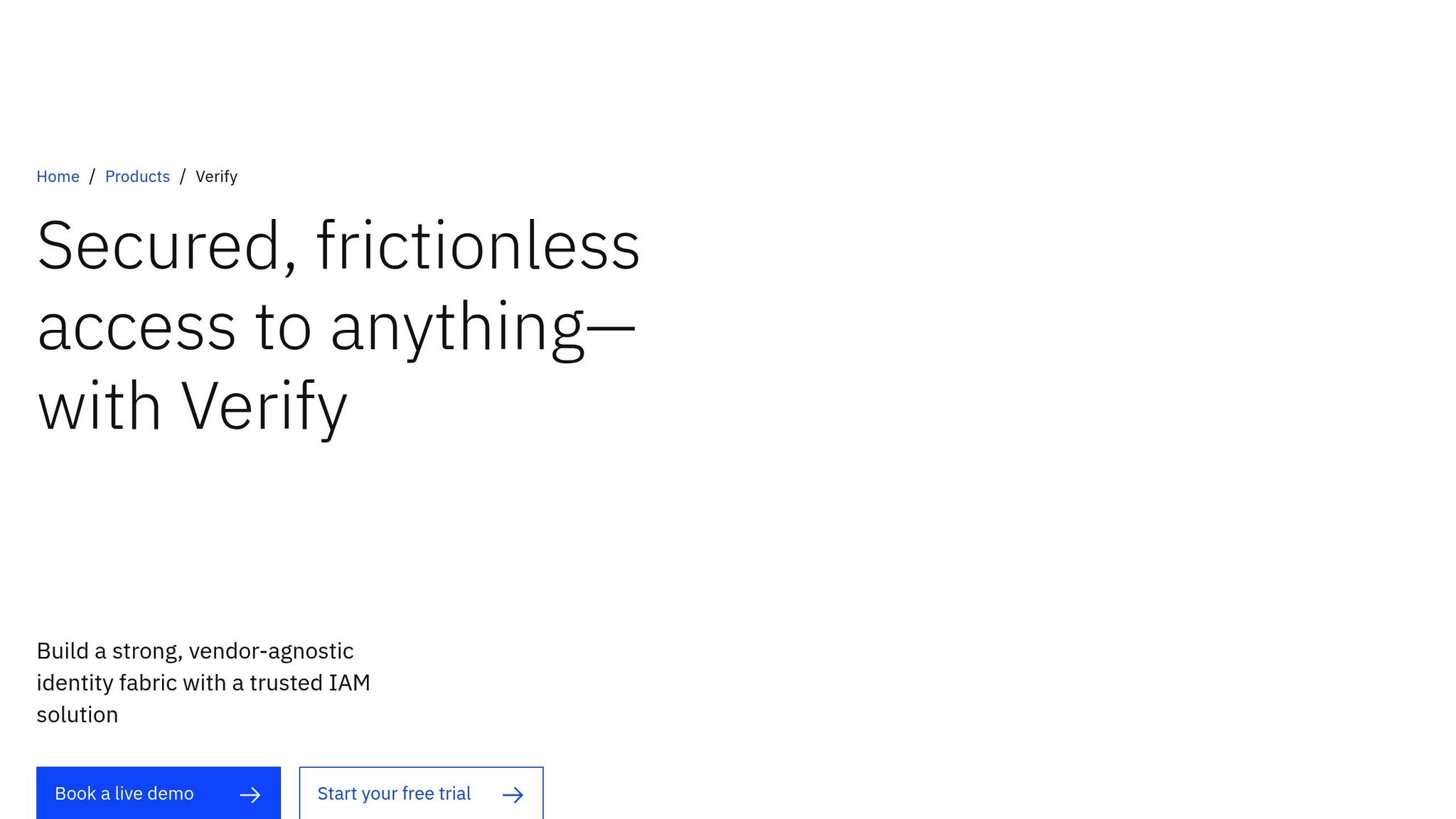
IBM Security Verify combines AI-powered risk analysis with enterprise-level compliance, offering a comprehensive security solution tailored for small and medium-sized enterprises (SMEs). It simplifies security management by eliminating the need for multiple standalone tools.
Real-Time Behavioral Analysis
With the help of IBM Security Trusteer, this platform continuously evaluates user behavior, device details, activity trends, environmental data (like geolocation and time), and behavioral biometrics to generate detailed risk scores. By comparing current actions against historical and peer data, it identifies anomalies and adjusts access in real-time. This adaptive access feature is particularly critical, given the reported 71% rise in attacks using valid credentials. IT teams can also filter authentication activity, diagnose issues, and analyze high-risk events in detail.
Compliance Support
IBM Security Verify is designed to ease compliance challenges, supporting standards like HIPAA, SOC 2, SOC 3, ISO 27001, and PCI DSS. This helps businesses reduce the time spent on audit preparations and minimizes risks tied to regulatory breaches - a key concern when the average cost of a data breach in 2022 reached $4.35 million .
Integration Capabilities
The platform is built to integrate seamlessly with existing SME systems. It supports various deployment models, including SaaS, on-premises, and hybrid setups. Adhering to standards like OpenID Connect, SAML 2.0, SCIM 2.0, and FIDO2, it ensures compatibility with diverse systems. With hundreds of pre-built application connectors and REST APIs, businesses can link their current infrastructure without the need for extensive development . Additionally, centralized user management is accessible through both an admin interface and REST APIs, while SCIM 2.0 enables smooth data provisioning between HR systems and applications.
Scalability for SMEs
IBM Security Verify’s scalability is a standout feature, with deployments supporting over 27 million users. It has earned strong ratings across platforms like G2 (4.3/5), Gartner Peer Insights (4.5/5), and TrustRadius (8.1/10) . Users often highlight its robust security and automation capabilities, though SMEs should be aware of potential challenges, such as setup complexity, a learning curve, mobile app performance issues, and a pricing model that can be hard to predict. One success story comes from Valor de Logistica Integrada, which reported a 99% improvement in user access delivery after implementing the platform.
4. SailPoint IdentityNow
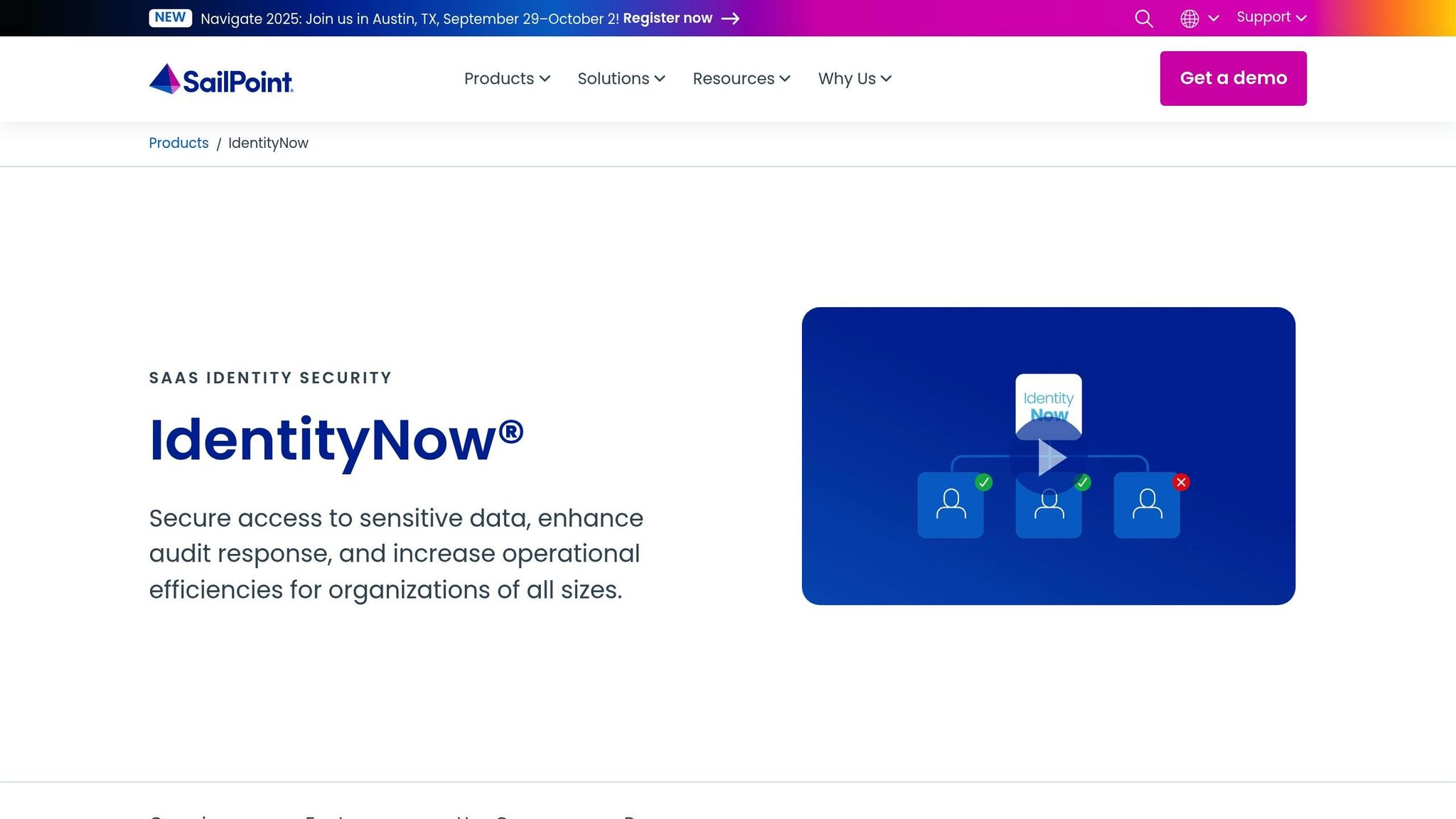
SailPoint IdentityNow is a robust Identity-as-a-Service (IDaaS) platform designed to simplify identity management for small and medium-sized enterprises (SMEs). By centralizing essential identity security tools and processes, it helps businesses streamline operations while enhancing security.
Real-Time Behavioral Analysis
SailPoint IdentityNow uses advanced automation to make access decisions by continuously monitoring user behavior and identifying unusual patterns. By analyzing peer activities, the platform recommends suitable access levels and automatically adjusts permissions when roles shift, cutting down mapping time by as much as 70%.
This reduction in mapping time is a game-changer for IT teams, freeing them up to focus on strategic tasks instead of manual access management. Additionally, the platform’s proactive monitoring supports compliance efforts, as discussed below.
Compliance Support
With identity-related regulations increasing sevenfold globally from 2010 to 2024, SailPoint IdentityNow is built to handle complex compliance requirements. It supports key standards like GDPR, HIPAA, and SOX, while also maintaining SOC 2 Type II compliance as a SaaS service.
The platform simplifies compliance by automating access reviews, certifications, and reporting. This ensures that all access is appropriate and authorized, which is essential for maintaining audit trails. Automating these processes not only minimizes manual effort but also speeds up audits and regulatory reporting.
Real-world success stories highlight the platform’s compliance benefits. For instance, The Home Depot adopted SailPoint to meet stringent compliance and audit demands. David Hetzler, Director of Cybersecurity, shared:
"We required a solution that would allow us to keep up with compliance and audit demands so we could solve other challenges. SailPoint was a solution to meet those complex needs."
Similarly, Vodafone saw significant improvements in efficiency. Serdar Calin, Access Governance and Identity Management Architect, noted:
"SailPoint reduced provisioning and onboarding time from as much as six hours to less than 10 minutes. That was a huge enhancement for our team. We also replaced our system of running manual audit reports with the auto-generated audit and compensation control reports from SailPoint."
Integration Capabilities
SailPoint IdentityNow shines in its ability to integrate seamlessly with a wide range of systems. It offers an extensive library of connectors, supporting popular platforms like Amazon Web Services (AWS), Microsoft Active Directory, and Salesforce.
SMEs can leverage various integration options, including VA-based, SaaS, and file-based connectors. These integrations can be developed in-house, through partnerships, or using open-source tools. For businesses using multiple SaaS applications, the platform’s SaaS Management feature adds another layer of functionality. It maps SaaS applications to IdentityNow sources, provides activity data for certifications, and enables webhooks to trigger workflows and send scheduled report data.
Scalability for SMEs
SailPoint IdentityNow is built to grow with businesses. Grady Summers, EVP of Product at SailPoint, highlighted recent automation advancements, explaining:
"Our new capability is expected to allow customers to shorten that process to hours or days, enabling their business-critical applications to be brought safely under their identity security umbrella with a minimal investment of time or energy. Automating this process will make it easier for customers to implement effective identity security capabilities across their entire digital ecosystem."
The platform excels in user lifecycle management, compliance management, and application integration, making it an ideal choice for SMEs. By centralizing identity security processes while remaining flexible enough to support future growth, SailPoint IdentityNow offers a practical, scalable solution for businesses aiming to enhance their identity governance efforts.
5. ForgeRock Identity Platform
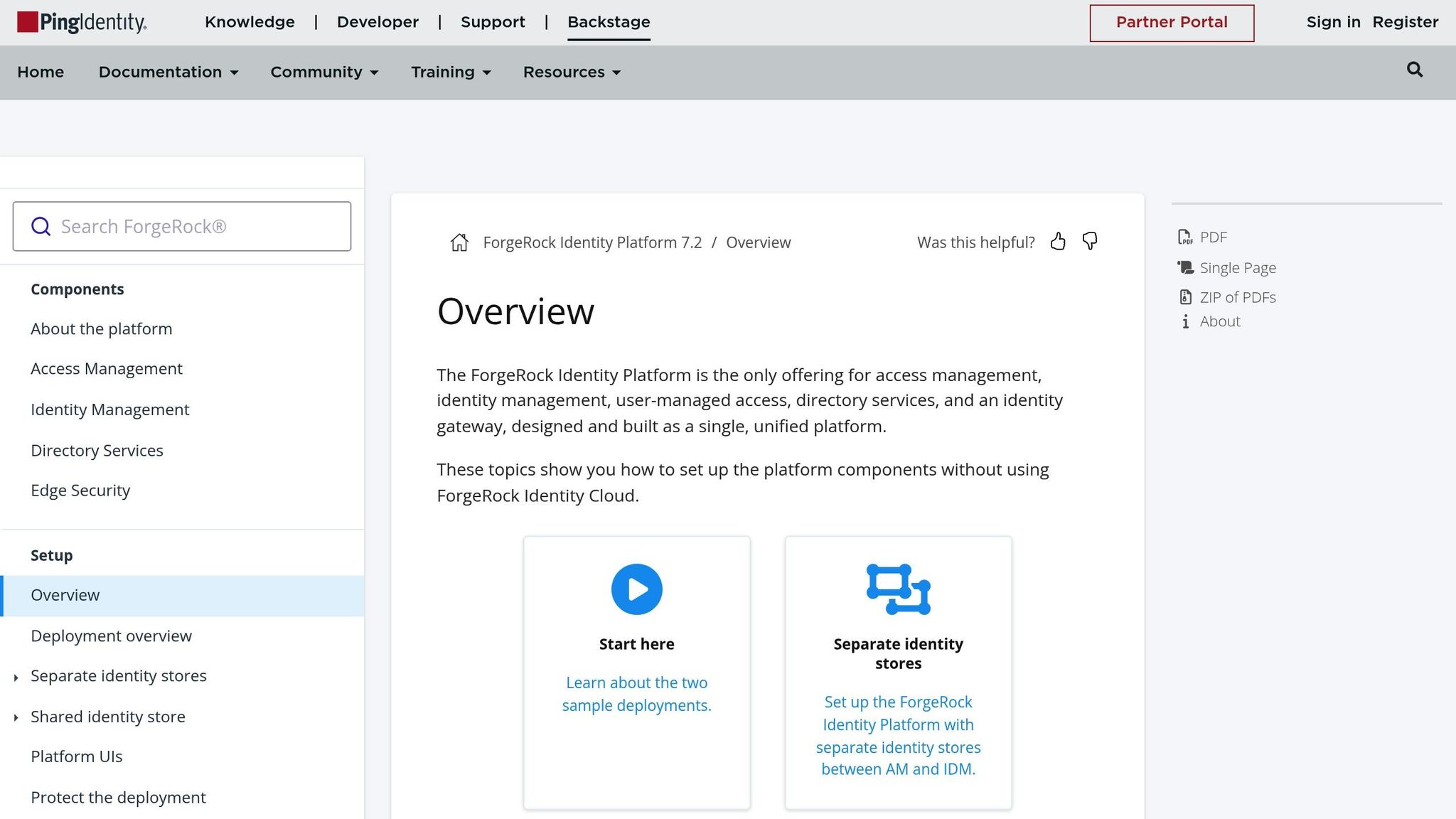
The ForgeRock Identity Platform offers a unified solution for identity management, combining access management, user-managed access, directory services, and an identity gateway. This all-in-one approach is particularly appealing for small and medium-sized enterprises (SMEs) aiming to simplify their identity security processes while staying protected against ever-changing cybersecurity threats.
Real-Time Behavioral Analysis
ForgeRock takes adaptive security to the next level by incorporating advanced behavioral analysis. Through its integration with BehavioSec, the platform continuously monitors user behavior. By analyzing factors like keystrokes, cursor movements, screen pressure, and how devices are handled, the system - powered by BehavioSense - creates unique user profiles and assigns a Behavioral Score. This score is crucial in detecting anomalies that could signal bot activity, Remote Access Trojans (RATs), or other malicious behaviors.
The platform doesn’t stop there. It also evaluates non-behavioral data, such as IP addresses, to enhance its detection capabilities. If a user's similarity score drops below a predefined threshold, ForgeRock triggers step-up authentication measures to confirm the user's identity, even if the device has been compromised mid-session. This passive verification helps IT teams efficiently identify and address security threats, prioritizing potential breaches effectively.
Compliance Support
ForgeRock meets stringent compliance standards, including HIPAA and SOC 2 Type II certification. According to the 2021 ForgeRock Consumer Identity Breach Report, the healthcare sector has become a primary target for cyberattacks. In response to this, ForgeRock achieved HIPAA compliance in September 2021, meeting the Health Information Technology for Economic and Clinical Health (HITECH) notification requirements. Russ Kirby, ForgeRock’s Chief Information Security Officer, highlighted this accomplishment:
"The ForgeRock Identity Cloud's HIPAA compliance is further validation of our commitment to give healthcare customers a safe and secure way to protect electronic health information."
Given the staggering 256% increase in hacking-related breaches and a 264% surge in ransomware incidents over the last five years, ForgeRock Access Management is designed to help organizations enforce robust security policies and adapt to ever-changing compliance needs.
Integration Capabilities
Built on a standards-based architecture, ForgeRock integrates effortlessly with a wide range of applications and services. Its key components - Access Management (AM), Identity Management (IDM), Directory Services (DS), and Identity Gateway (IG) - work together seamlessly. The Identity Gateway, in particular, allows organizations to connect web applications, APIs, and microservices without requiring modifications to their existing systems.
Additionally, ForgeRock supports containerized deployments on Kubernetes, enabling SMEs to adopt cloud-native technologies with ease. This flexibility ensures that businesses can modernize their infrastructure while maintaining compatibility with their current systems.
Scalability for SMEs
ForgeRock's unified architecture eliminates the need for multiple point solutions, making it especially attractive for SMEs. Mohamed B. shared his experience with the platform:
"Their access management solution, OpenAM, is most valuable because it meets the needs of a lot of users. ForgeRock secured our system so that it is accessed only by authorized people, and it implemented the SSO."
With an average rating of 8.0, ForgeRock stands out for its intelligent authentication capabilities and adaptability to various environments. Its strong integration features ensure smooth operations across different technology stacks, making it an excellent choice for SMEs looking to scale while maintaining high security standards. This cohesive approach underscores ForgeRock's strength as a key player in the evolving landscape of user role adaptation.
sbb-itb-bec6a7e
6. One Identity Manager
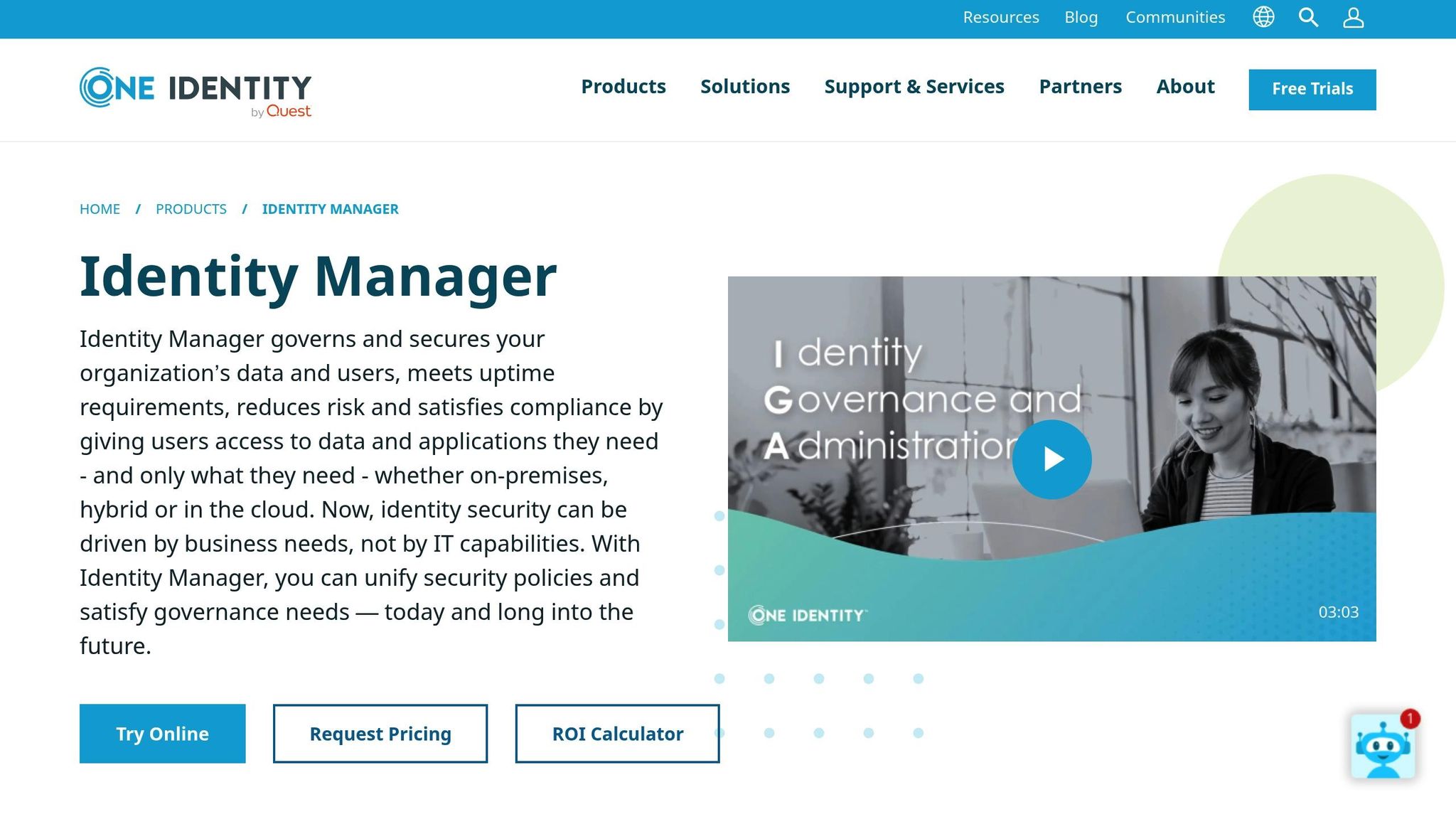
One Identity Manager stands out as a solution tailored to meet the needs of small and medium-sized enterprises (SMEs). With its focus on identity governance and dynamic user role management, it serves over 11,000 organizations globally, managing more than 500 million identities. By blending advanced analytics with extensive customization options, it simplifies the complexities of identity management, making it a practical choice for SMEs.
Real-Time Behavioral Analysis
Using advanced machine learning algorithms, One Identity Manager monitors user behavior to adjust access controls in real time. By analyzing patterns and establishing a baseline for normal behavior, it ensures permissions align with actual usage.
The platform's Safeguard for Privileged Analytics (SPA) enhances this capability by integrating data from Safeguard for Privileged Sessions. This feature creates detailed, real-time profiles for privileged users, using 13 machine learning algorithms to analyze biometric data like keystroke dynamics and mouse movements. These insights help detect anomalies and assess risks effectively.
Rob Byrne, Field Strategist at One Identity, highlights the practical application of these tools:
"Maybe this guy should have this access or should not have this access."
Additionally, the Behavior-Driven Governance (BDG) feature seamlessly combines access management with identity governance. This enables organizations to enforce a least-privilege model by monitoring usage patterns and suggesting or automatically revoking unnecessary permissions. BDG ensures that access controls evolve with security needs.
Compliance Support
One Identity Manager is designed to meet key compliance standards, supporting frameworks such as SOC 2 Type 2, SOC 3, and HIPAA. For healthcare organizations, it provides tailored documentation, including SOC 2 Type 2 reports that align tested controls with HIPAA requirements. The platform also adheres to international standards like ISO 27001:2013, ISO 27017:2015, and ISO 27018:2019, while mapping controls to FFIEC guidelines and the NIST Cybersecurity Framework.
This compliance-driven approach is especially critical given that credential misuse accounted for 44.7% of data breaches in 2023, and 78% of Americans admit to reusing passwords. These features make One Identity Manager a valuable tool for SMEs aiming to strengthen their security posture.
Integration Capabilities
One Identity Manager excels in its ability to integrate with a wide range of systems. It supports native connectors, Starling Connect, and custom solutions, ensuring compatibility with popular platforms like SAP, ServiceNow, AWS, Microsoft Azure, and Google Suite. Its support for modern protocols such as SAML, OpenID Connect, and SCIM allows for quick and reliable integration with cloud-based applications, which is particularly beneficial for SMEs adopting SaaS tools. This seamless connectivity ensures long-term reliability and scalability.
Scalability for SMEs
With its flexible architecture and robust feature set, One Identity Manager is well-suited for growing SMEs. The platform has a 4.0 out of 5 rating on PeerSpot, with 90% of users recommending it. A Senior Identity and Security Specialist praised its adaptability:
"The best feature of this solution is its flexibility to be customized. It is like a framework. You can customize it very far from its core functionality, and it will still work."
Similarly, an Enterprise IT Architect highlighted:
"What I like the most is the flexibility or configurability. It is not like you are writing huge lines of code. It allows us to handle our very complex enterprise use cases, and we have many of those."
The platform also offers a business roles feature, enabling organizations to map their structures for dynamic application provisioning. This provides full visibility into data access and ensures clear reporting for regulatory compliance. As more SMEs transition to hybrid and multi-cloud environments, One Identity Manager’s scalable design positions it as a reliable choice for navigating diverse technology landscapes.
Next, we’ll take a closer look at another solution that enhances adaptive behavioral profiling.
7. Ping Identity
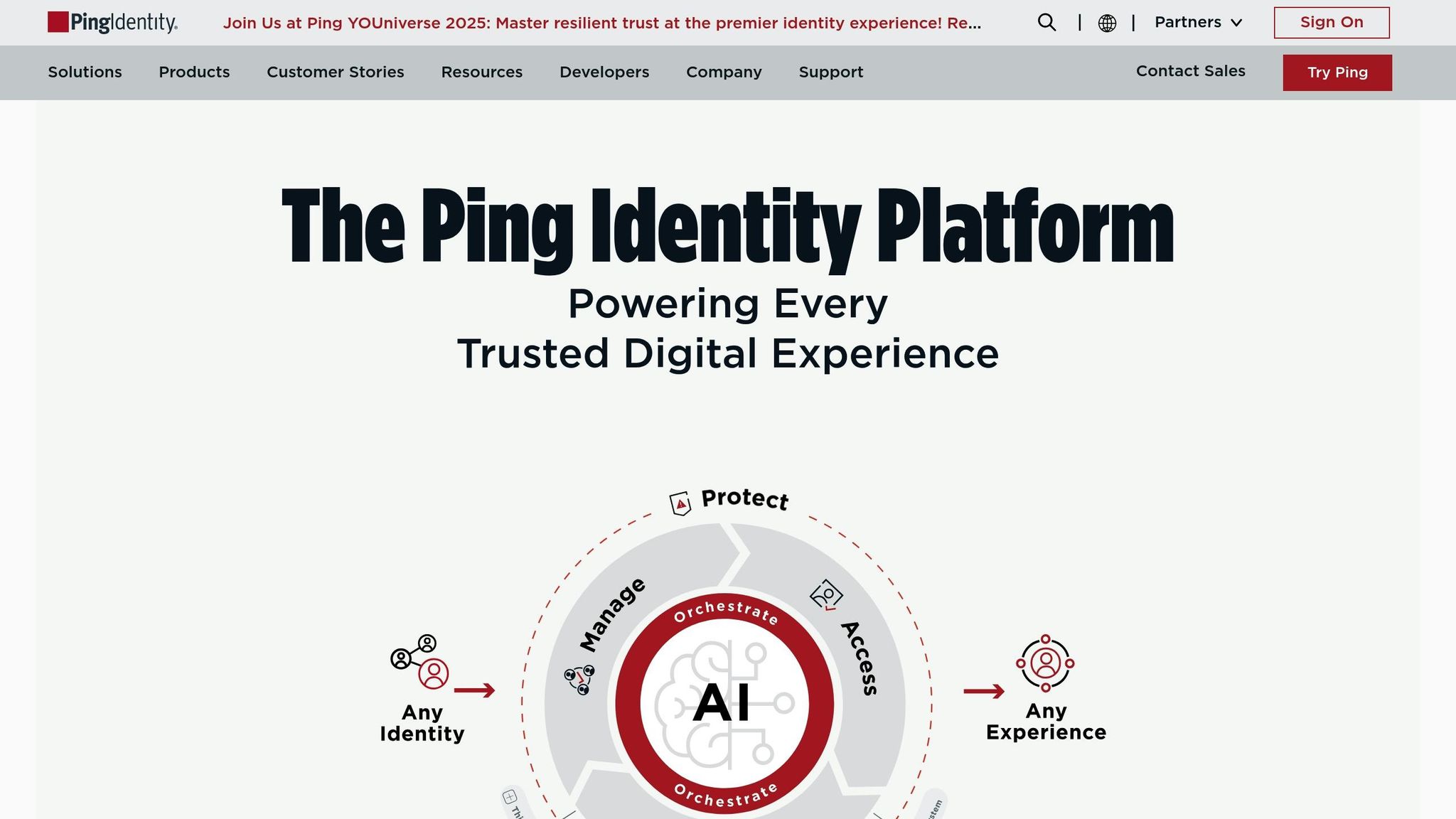
Rounding out our list, Ping Identity stands out for its ability to combine real-time behavioral insights with seamless system integration. This identity and access management platform uses AI-powered risk assessment and offers robust security features, making it a solid choice for modern small and medium-sized enterprises (SMEs).
Real-Time Behavioral Analysis
Ping Identity’s risk-based authentication constantly monitors user behavior to dynamically adjust access permissions and roles. By regularly updating user profiles, the system calculates risk scores and reacts to potential threats, such as stolen or compromised credentials. It analyzes risk signals like device reputation, network activity, and behavioral biometrics to maintain security. If unusual activity is detected, the platform automatically tightens controls for high-risk scenarios without disrupting legitimate users. Organizations can also customize their risk policies, such as enabling step-up authentication when risk scores surpass set thresholds, to suit their unique security needs.
This adaptive approach forms the backbone of Ping Identity’s security and compliance capabilities.
Compliance Support
Ping Identity is equipped with key certifications that are critical for industries with strict regulatory requirements. The platform is SOC 2 Type 2 and ISO 27001 certified, including ISO 27018 for safeguarding personal data in cloud environments. Its Information Security Management System (ISMS) undergoes regular audits by both internal teams and independent external experts to ensure compliance with various regulations. For government and highly regulated sectors, Ping Identity offers the Ping Government Identity Cloud, which is DOD IL5-certified and FedRAMP High authorized. Additionally, SMEs can configure the system to align with NIST guidelines on password policies, session management, and lockout procedures.
"At Ping Identity, we understand the privacy risks that individuals and organizations encounter every day. Thousands of companies trust us to protect their users. Here's how we do it."
This strong compliance framework is complemented by its smooth integration capabilities.
Integration Capabilities
Ping Identity works effortlessly with existing SME systems, supporting open standards like SAML, OAuth, and SCIM. Its PingFederate solution manages identity and access across a range of environments, including cloud, mobile, SaaS, APIs, and on-premises systems.
Scalability for SMEs
Built to grow with businesses, Ping Identity provides flexible security controls that can be tailored to an organization’s specific needs. Monil Naicker, Director of Identity, Security and Access Management at Applied Materials, underscores its importance:
"Ping is a critical part of our authentication ecosystem. It helps us achieve access and identity where we need it the most."
The platform also simplifies modernization for organizations transitioning from older systems. For instance, a civilian agency successfully replaced its legacy IAM, federation, and directory components with Ping Identity, enabling scalable, interagency federated access while maintaining support for legacy applications.
With Ping Identity completing our lineup, it’s time to compare these tools side by side.
Tool Comparison Table
Selecting the right tool for your business involves weighing performance across several critical areas. Below, we've outlined how various tools measure up for small and medium-sized enterprises (SMEs).
| Tool | Real-Time Adaptation | Compliance Support | Ease of Integration | Pricing Transparency | SME Suitability |
|---|---|---|---|---|---|
| Okta Adaptive MFA | AI-powered risk assessment with behavioral analytics | SOC 2, ISO 27001, FedRAMP certifications | 7,000+ pre-built integrations | Custom pricing (~$2/user/month) | Scalable plans with extensive documentation |
| Microsoft Entra ID | Conditional access with machine learning insights | Comprehensive compliance certifications | Native Office 365 integration | Tiered pricing (starts at $6/user/month) | Familiar interface, ideal for gradual adoption |
| IBM Security Verify | Advanced AI with contextual authentication | Enterprise-grade compliance framework | Requires technical expertise | Contact for pricing | Complex for smaller teams |
| SailPoint IdentityNow | Automated provisioning with role recommendations | Regulatory compliance focus | Cloud-first but needs configuration | Enterprise pricing model | Best suited for larger organizations |
| ForgeRock Identity Platform | Intelligent authentication with adaptive policies | Multi-industry compliance support | API-first architecture | Custom enterprise pricing | Flexible but complex setup |
| One Identity Manager | Policy-driven automation | Audit and compliance reporting | Hybrid deployment options | Quote-based pricing | Primarily enterprise-focused |
| Ping Identity | Behavioral analysis with real-time risk scoring | SOC 2, ISO 27001, FedRAMP High | SAML, OAuth, SCIM support | Tiered pricing available | SME-friendly features with scalability |
Key Considerations for SMEs
- Budget-conscious SMEs: Microsoft Entra ID and Okta Adaptive MFA stand out with their transparent and affordable pricing structures.
- Limited IT resources: Microsoft Entra ID offers seamless integration with Office 365, while Okta provides over 7,000 pre-built connectors to simplify implementation.
- Highly regulated industries: Ping Identity and IBM Security Verify excel in compliance support, making them ideal for sectors with strict regulatory requirements.
- AI-driven security: Okta, IBM Security Verify, and Ping Identity leverage advanced AI to enhance risk assessment and reduce false positives.
For SMEs embarking on digital transformation, it's crucial to prioritize tools that balance ease of integration, cost transparency, and scalability. Solutions requiring significant technical expertise or custom pricing can strain resources and delay implementation, making them less suitable for smaller teams.
How to Pick the Right Tool for Your SME
Now that we've covered the essential features to look for, let's dive into the practical steps for choosing the right tool for your SME. Finding the best dynamic user role adaptation tool requires a thoughtful approach that balances your specific business needs with real-world constraints. For SMEs in the U.S., challenges like budget limitations and compliance requirements often play a big role in the decision-making process.
Start with a Clear Cost-Benefit Analysis
Begin by conducting a cost-benefit analysis to understand the potential return on investment (ROI). Studies show that 74% of organizations meet or exceed their expected ROI from advanced AI initiatives. Moreover, AI adoption can reduce costs by 15.2% and increase revenue by 15.8%.
"By integrating AI, SMEs can unlock greater efficiencies and harness the power of data-driven decision making. However, the journey is nuanced and requires a strategic approach." – Ciaran Connolly, ProfileTree Founder
Keep in mind that the upfront costs of AI tools are often underestimated by 40–60%. Be sure to account for expenses like licensing, training, integration, and ongoing maintenance. On average, businesses spend between $100 and $5,000 per month on AI solutions, with 95% reporting satisfaction with their ROI. After assessing costs, evaluate your current IT setup to ensure the tool you choose will integrate smoothly.
Assess Your Current IT Infrastructure
After examining potential ROI, take a close look at your existing IT infrastructure. For businesses already using Office 365, Microsoft Entra ID offers seamless integration without the need for major changes. If your company relies on a mix of applications, Okta's 7,000+ pre-built integrations might be a better fit.
Also, consider the technical expertise of your team. Tools like IBM Security Verify and ForgeRock are feature-rich but may require advanced technical skills to implement effectively. For SMEs with limited IT resources, prioritize solutions that have user-friendly interfaces and thorough documentation.
Meet US Regulatory Standards
Compliance is another critical factor, especially in highly regulated industries. For example, healthcare organizations must comply with HIPAA, while financial services must adhere to SOC 2 standards. Tools like Ping Identity and IBM Security Verify are designed for such environments, offering built-in compliance frameworks and audit capabilities.
A report from the U.S. Chamber of Commerce in 2024 revealed that 25% of small businesses not using AI cite legal or compliance concerns as their main obstacle. To address this, consider hiring legal counsel with expertise in AI regulations or working with vendors that offer compliance support.
"The challenge is understanding and keeping up with the state requirements. It's like a moving ball because the states are constantly changing their laws." – Freda Pepper, Sovos General Counsel
Plan Your Implementation Strategy
Adopt a phased approach to implementation, starting with small pilot projects. Focus on high-impact areas that align with your business goals and set clear metrics for success. Before you begin, define what "relevant information" means for your use case and craft data goals using a hypothesis-driven approach.
Engaging stakeholders early is key to aligning expectations. Make sure to plan for data access and IT resources well in advance. Documenting your decisions throughout the process will help build trust and confidence among your team. With a solid plan in place, prioritize tools that can scale as your business grows.
Consider Scalability and Growth
Choose solutions that can grow alongside your business. Both Microsoft Entra ID and Okta Adaptive MFA offer pricing models designed to scale without requiring major system overhauls. Avoid tools that lock you into rigid contracts or demand significant reinvestment as your needs evolve.
Top-performing companies report a 13% ROI on AI projects, compared to the average ROI of 5.9%. This performance gap often comes down to selecting tools that adapt to growth rather than needing frequent replacements or costly upgrades.
Test Before You Commit
Before committing to a full rollout, run a small pilot with clear objectives. Use measurable metrics to evaluate the tool’s performance and gather feedback from actual users. Regularly assessing progress during the pilot phase allows for adjustments and improvements.
Many vendors offer trial periods or proof-of-concept implementations, giving you the chance to test the tool's capabilities in real-world scenarios before making a financial commitment.
Budget for Success
Create a detailed budget that accounts for all costs, from upfront expenses to long-term maintenance. Include a timeline for expected savings and revenue growth. Remember, AI deployment often automates routine tasks, freeing up resources for more strategic activities. On average, productivity for support teams increases by 13.8% after AI implementation. Factor these gains into your ROI projections.
Build Internal Capabilities
To ensure successful implementation, invest in training your team. Building AI proficiency is essential for aligning the tool with your company’s strategic goals. Establish governance frameworks and appoint a dedicated officer to oversee AI compliance and ensure adherence to regulations.
Foster a culture of continuous learning around the tool you choose. The most successful implementations integrate solutions into daily workflows, making them a natural part of your operations rather than an isolated system requiring special attention.
About AI for Businesses
Navigating the world of AI tools can feel like a daunting task for small and medium enterprises (SMEs). That’s where AI for Businesses steps in - a dedicated directory offering a carefully curated selection of AI tools designed to help SMEs and scale-ups streamline their operations.
The demand for AI solutions is undeniable. A staggering 98% of small businesses now utilize AI tools. This shift highlights how AI has transitioned from being a luxury to an essential part of staying competitive. As Blaise Radley from Workday US puts it, "AI is becoming the standard for modern small businesses, driving efficiencies and powering smarter decisions across functions".
SMEs face unique hurdles when adopting AI. Unlike large corporations with vast IT resources and budgets, smaller businesses need solutions that integrate seamlessly into their existing systems and deliver immediate benefits. AI for Businesses focuses on tools that assist SMEs in processing data more effectively, making smarter decisions, automating repetitive tasks, and creating engaging content to connect with their audience.
The directory includes a wide array of AI applications, covering everything from design tools to resume optimization, image generation, and content creation. Each tool is carefully evaluated to meet the specific needs of SMEs. This attention to quality is vital, especially since nearly 90% of small and medium-sized business teams are already using AI.
In addition to business tools, the platform emphasizes cybersecurity solutions tailored for dynamic user role adaptation. For businesses adopting this approach, AI for Businesses features identity management tools designed to simplify user permissions. These solutions focus on strong threat detection, advanced data protection, and efficient cybersecurity measures, which are critical for securing modern business operations.
What sets AI for Businesses apart is its commitment to practicality. The platform recognizes that SMEs need AI strategies that address real-world challenges, such as system integration and employee training. Instead of overwhelming users with complex enterprise-grade solutions, the directory highlights tools that are easy to implement and immediately effective. This approach extends to its coverage of essential identity management solutions.
The impact of AI adoption is hard to ignore - businesses report up to 30% annual revenue growth and a 40% boost in productivity . To accommodate businesses of varying sizes and budgets, AI for Businesses offers three pricing plans: Basic (free), Pro ($29/month), and Enterprise (custom). For resource-strapped SMEs, these gains can be game-changing.
Paul Daugherty, Chief Technology and Innovation Officer at Accenture, underscores the urgency: "The playing field is poised to become a lot more competitive, and businesses that don't deploy AI and data to help them innovate in everything they do will be at a disadvantage".
Conclusion
Dynamic user role adaptation tools offer small and medium-sized enterprises (SMEs) a way to bolster security while significantly cutting certification times - by as much as 65%. At the same time, these tools improve the accuracy of access revocations by 45%. These numbers highlight their potential to deliver real-time, meaningful security enhancements.
AI-powered identity and access management solutions further strengthen security by reducing identity-related breaches by 60% and addressing risks posed by internal actors. Considering that 34% of data breaches involve insiders, and breaches can cost an average of $4.88 million, this layer of protection is essential.
"Anomaly detection offers a proactive solution by identifying unusual network behavior in real time. It alerts teams to potential threats before they cause significant damage." - Zac Amos, Features Editor, ReHack
These tools also bring the flexibility SMEs need to adapt in a fast-changing business environment. By enabling real-time adjustments to access permissions based on contextual factors, dynamic user role adaptation moves away from outdated, static systems that struggle to keep up with modern security challenges. This adaptability becomes even more critical as SMEs increasingly rely on digital tools and interconnected networks to maintain their competitive edge.
Beyond security, these solutions drive efficiency by automating routine access management tasks. AI-driven tools can eliminate unnecessary permissions, streamline user access reviews, and detect risky patterns - all while reducing the workload for IT teams. For businesses with limited resources, this automation not only cuts costs but also frees up teams to focus on strategic priorities rather than repetitive tasks.
As digital transformation accelerates, SMEs that adopt dynamic user role adaptation will be better equipped to scale operations, meet regulatory requirements, and respond to shifting market demands. These tools lay the groundwork for fostering a security-focused culture that doesn’t compromise agility or growth.
In today’s competitive landscape, SMEs must embrace dynamic user role adaptation models to remain secure, efficient, and responsive - or risk being outpaced by competitors leveraging these AI-driven capabilities.
FAQs
How do tools for dynamic user role adaptation improve security for SMEs?
Dynamic tools for adjusting user roles are a game-changer for small and medium-sized businesses (SMEs) when it comes to security. These tools provide real-time, adaptable access controls, ensuring that user permissions can shift instantly based on behavior, context, or potential risks. This approach significantly lowers the risk of unauthorized access or insider threats.
On top of that, these tools streamline management by centralizing role administration. This makes it easier to oversee user activities, meet compliance requirements, and quickly identify unusual behavior. The result? Stronger security with less administrative effort - an ideal solution for businesses aiming to grow without added complexity.
What should SMEs look for when selecting a dynamic user role adaptation tool?
When selecting a tool for dynamic user role management, small and medium-sized businesses should focus on ease of use. A straightforward interface ensures that staff can pick it up quickly without requiring extensive training. Another key factor is the tool’s compatibility with your current systems and its ability to grow alongside your business.
It’s also essential to evaluate your organization’s preparedness for implementation. This includes examining your infrastructure, budget, and the expertise of your team. Look for a solution that not only fits your operational needs but also addresses challenges like managing costs and bridging knowledge gaps. The right tool can boost efficiency and simplify your workflows, making daily operations smoother.
Can these tools integrate with my current systems and ensure compliance with industry regulations?
Many AI tools designed for managing dynamic user roles are built to work effortlessly with your current systems. They typically rely on APIs and compatible interfaces to connect with enterprise applications and workflows, ensuring a smoother integration process with minimal disruption.
These tools also emphasize staying aligned with industry regulations. Features like governance frameworks, real-time monitoring, and strong security measures are often included to safeguard data and maintain compliance. This means your business can confidently adopt AI solutions while ensuring regulatory standards are met.


